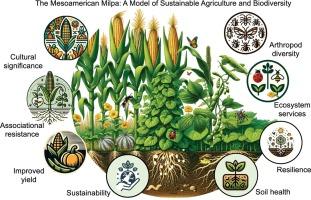The mesoamerican milpa system: Traditional practices, sustainability, biodiversity, and pest control
IF 3.7
2区 农林科学
Q2 BIOTECHNOLOGY & APPLIED MICROBIOLOGY
引用次数: 0
Abstract
The milpa system, an ancient Mesoamerican agricultural practice of intercropping, has sustained communities for centuries, providing food security and preserving biodiversity. Despite its agricultural significance, there exists a notable gap in understanding how this system preserves arthropod biodiversity and facilitates trophic interactions within the milpa community. This review aims to explore the milpa system, examining its historical significance, cultural importance, and ecological benefits and interactions, with a particular emphasis on conservation biological control. With a primary focus on Mexico, supplemented by examples from other countries in the Mesoamerican region, we cover the region that stands as the birthplace and cradle of milpa crop domestication. The review delves into the diversity of arthropods associated with common milpa crops, their roles in ecosystem functioning, and the implications for crop productivity and resilience. It also examines the potential of integrating traditional farming practices into modern agriculture to enhance beneficial interactions and mitigate potential pest pressures. By synthesizing current knowledge on arthropod ecology in the milpa system, this review provides insights that can help to promote sustainable agricultural practices rooted in indigenous knowledge and ecological principles.

中美洲密帕系统:传统做法、可持续性、生物多样性和虫害防治
milpa 系统是一种古老的中美洲间作农业耕作方式,几个世纪以来一直维持着社区的生计,既提供了粮食安全,又保护了生物多样性。尽管它对农业具有重要意义,但人们对这一系统如何保护节肢动物的生物多样性以及如何促进密帕群落内的营养相互作用的认识还存在明显的差距。本综述旨在探讨密蒙花系统,研究其历史意义、文化重要性、生态效益和相互作用,尤其侧重于保护性生物防治。我们以墨西哥为主要研究对象,辅以中美洲地区其他国家的实例,介绍了该地区作为密蒙花作物驯化的发源地和摇篮的情况。综述深入探讨了与常见小米草作物相关的节肢动物的多样性、它们在生态系统功能中的作用以及对作物生产力和恢复力的影响。它还探讨了将传统耕作方法融入现代农业的潜力,以加强有益的相互作用并减轻潜在的虫害压力。本综述综合了当前关于小米草系统节肢动物生态学的知识,提供了有助于促进植根于本土知识和生态原则的可持续农业实践的见解。
本文章由计算机程序翻译,如有差异,请以英文原文为准。
求助全文
约1分钟内获得全文
求助全文
来源期刊

Biological Control
生物-昆虫学
CiteScore
7.40
自引率
7.10%
发文量
220
审稿时长
63 days
期刊介绍:
Biological control is an environmentally sound and effective means of reducing or mitigating pests and pest effects through the use of natural enemies. The aim of Biological Control is to promote this science and technology through publication of original research articles and reviews of research and theory. The journal devotes a section to reports on biotechnologies dealing with the elucidation and use of genes or gene products for the enhancement of biological control agents.
The journal encompasses biological control of viral, microbial, nematode, insect, mite, weed, and vertebrate pests in agriculture, aquatic, forest, natural resource, stored product, and urban environments. Biological control of arthropod pests of human and domestic animals is also included. Ecological, molecular, and biotechnological approaches to the understanding of biological control are welcome.
 求助内容:
求助内容: 应助结果提醒方式:
应助结果提醒方式:


